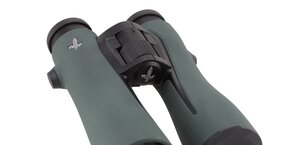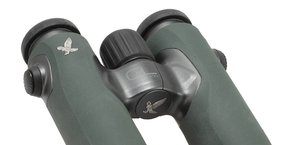Hawke Frontier ED X 8x42
According to official declarations of the producers, the Frontier ED X binoculars are supposed to feature everything a flagship, top-of-the-range device has to have nowadays. There is low dispersion ED glass in the optical system, all air-to-glass surfaces are fully multi-coated, Schmidt-Pechan roof prisms, phase correction and dielectric coated, are made of BaK-4 glass,. Apart from that the objective lenses have hydrophobic layers to repell water and moisture.
The chassis is made of magnesium alloy and covered by high-quality rubber armour. The binoculars are fully sealed, nitrogen purged and waterproof.
 |
| Magnification | Lens diameter | Angular field of view | Prisms | Eye relief | Weight | Price |
|---|---|---|---|---|---|---|
| 8 | 42 | 142/1000(8.1o) | BaK-4/roof | 18 mm | 692 g | 1699 PLN |
Summary
Pros:
- shapely, stylish chassis made of magnesium alloy,
- very good correction of chromatic aberration,
- slight astigmatism,
- excellent colour rendition,
- good quality prisms made of BaK-4 glass,
- proper blackening and cleanliness inside the tubes,
- coatings of sensible quality cover all air-to-glass surfaces.
Cons:
- distinct distortion,
- sharpness on the edge of the field of view leaves a bit to be desired,
- discrepancies between declared and real parameters,
- noticeable brightness loss on the edge of the field of view.
 |
It's not the end of good news.The binoculars look very sturdy, with their magnesium chassis. It is completely waterproof and, at the same time, it is supposed to weigh just 692 grams, a very good result in the 42 mm class. The accessory kit you get is impressive, the warranty period - quite long. Inside the instrument you get low dispersion ED glass and prisms which feature phase correction and dielectric coating. All of that for a very sensible price of 400 Euro.
I admit our expectations were high and we hoped that, after our test, we would present to our Readers another interesting and completely recommendable pair of binoculars.
Now time for a reality check. The binoculars let us down a bit. First of all we found out the producers are not exactly precise with official parameters. For example the field of view is not 8.1 but 7.8 degrees. Don't get me wrong – 7.8 degrees remains a pretty good result in this class but such a discrepancy leaves bad taste in my mouth. Similar things can be said about the weight – instead of declared 692 grams you get 721 grams. The difference is not huge but it's a pity it doesn't favour the buyer. Then comes magnification – instead of declared 8x you get something near 7.7x. Such slip-ups can happen, and can be tolerated, only in basic and cheapest pieces of equipment, not in a case of a pair of binoculars with the 400 Euro price tag.
Hawke Frontier ED X 8x42, Vortex Diamondback HD 10x42 and Vortex Razor UHD 10x42. |
As you see there are a lot of complaints but their number doesn't mean the binoculars don't have any assets, quite the contrary. Let's look at the transmission graph, presented below.
 |
You should also mention very good astigmatism correction, an important factor when it comes to properly contrasted, high quality images, and influence of ED glass elements which performs very well - chromatic aberration is properly curbed not only in the centre but also on edges of the field.
Of course you shouldn't forget high build quality, cleanliness and proper darkening of interiors of the tubes.
If you buy the Hawke Frontier ED X 8x42 pairs of binoculars you'll be pleased with their performance providing that you won't compare it too often with direct rivals; however if you do so you might find out that on the market there are similarly good pairs of binoculars, or even a tad better ones, to be had for a lower price. In order not to sound groundless we can quote here the Bushnell Forge 8x42, the Delta Optical Chase 8x42, the Olympus PRO 8x42 or a bit more expensive Nikon Monarch 7 8x42. Such a group of strong rivals means the Frontier's ED X market success might be rather difficult to achieve.


















